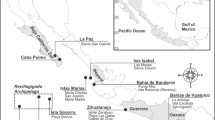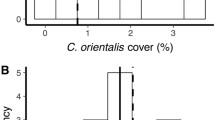Abstract
Coral reef sponge populations were surveyed at two spatial scales: different depths and different reef locations across the continental shelf of the central Great Barrier Reef. The surveys were conducted on the forereef slopes of 12 reefs from land-influenced, inner-shelf reefs to those in the oligotrophic waters of the Coral Sea. Few sponges occur in shallow waters and the largest populations are found between 10 and 30 m depth. Sponges are apparently excluded from shallow waters because of excessive turbulence and possibly by high levels of damaging light. Sponge biomass is highest on the innershelf reefs and decreases away from the coast, whereas abundance is generally higher on middle-shelf reefs. There are considerable overlaps in the species composition on middle-, outer-shelf and Coral Sea reefs, but those on inner-shelf reefs are significantly different. The nature and size of sponge populations reflect environmental conditions across the continental shelf. The larger inner-shelf populations probably reflect higher levels of organic and inorganic nutrients and reduced amounts of physical turbulence, whereas sponges on reefs further from shore may be able to resist greater turbulence but appear more sensitive to the effects of fine sediments. These latter populations are smaller, reflecting the reduced availability of organic matter, however, many of these sponges rely on cyanobacterial symbionts to augment nutrition in these clearer, more oligotrophic waters.
Similar content being viewed by others
References
Andrews JC (1983) Water masses, nutrient levels and seasonal drift on the outer central Queensland shelf (Great Barrier Reef). Aust J Mar Freshw Res 34:821–834
Bergquist PR (1978) Sponges, Hutchinson, London
Dinesen ZD (1983) Patterns in the distribution of soft corals across the central Great Barrier Reef. Coral Reefs 1:229–236
Done TJ (1982) Patterns in the distribution of coral communities across the central Great Barrier Reef. Coral Reefs 1:95–107
Furnas MJ, Mitchell AW (1986) Phytoplankton dynamics in the central Great Barrier Reef — I. Seasonal changes in biomass and community structure and their relation to intrusive activity. Cont Shelf Res 6:363–384
Gower JC (1966) Some distance properties of latent root and vector methods used in multivariate analysis. Biometrika 53:325–338
Hammond LS, Birtles RA, Reichelt RE (1985) Holothuroid assemblages on coral reefs across the central section of the Great Barrier Reef. Proc 5th Int Coral Reef Symp 5:285–290
Johnson DP, Belperio AP, Hopley D (1986) A field guide to mixed terrigenous-carbonate sedimentation in the central Great Barrier Reef province, Australia. Australasian Sedimentologists Group Field Guide Series no 3. Geological Society of Australia, Sydney
Jokiel PL (1980) Solar ultraviolet radiation and coral reef epifauna. Science 207:1069–1071
Krebs CJ (1978) Ecology: the experimental analysis of distribution and abundance, 2nd edn. Harper and Row, New York
Lerner IM, Dempster ER (1962) Indeterminism in interspecific competition. Proc Natl Acad Sci USA 48:821–826
Palumbi SR (1984) Tactics of acclimation: morphological changes of sponges in an unpredictable environment. Science 225:1478–1480
Russ G (1984) Distribution and abundance of herbivorous grazing fishes in the central Great Barrier Reef I. Levels of variability across the entire continental shelf. Mar Ecol Prog Ser 20:23–34
Sammarco PW, Crenshaw H (1984) Plankton community dynamics of the central Great Barrier Reef Lagoon: Analysis of data from Ikeda et al. Mar Biol 82:167–180
Ullman WJ, Sandstrom MW (1987) Dissolved nutrient fluxes from the nearshore sediments of Bowling Green Bay, central Great Barrier Reef Lagoon. Est Coast Shelf Sci 24:289–303
Veldmann DJ (1967) Fortran programming for behavioural sciences. Holt, Rinehart and Winston, New York
Walker TA, O'Donnell G (1981) Observations on nitrate, phosphate and silicate in Cleveland Bay, northern Queensland. Aust J Mar Freshw Res 32:877–887
White J (1985) The population structure of vegetation. In: White J (ed) Handbook of vegetation science. Junk, The Hague
Wilkinson CR (1982) Significance of sponges with cyanobacterial symbionts on Davies Reef, Great Barrier Reef. Proc 4th Int Coral Reef Symp 2:705–712
Wilkinson CR (1983) Net primary productivity in coral reef sponges. Science 219:410–412
Wilkinson CR (1986) The nutritional spectrum of coral reef benthos. Oceanus 29(2):68–75
Wilkinson CR (1987a) Interocean differences in size and nutrition of coral reef sponge populations. Science 236:1654–1657
Wilkinson CR (1987b) Productivity and abundance of large sponge populations on Flinders Reef flats, Coral Sea. Coral Reefs 5:185–188
Wilkinson CR (1988) Foliose Dictyoceratida of the Australian Great Barrier Reef. II. Distribution of these prevalent sponges. PSZNI Mar Ecol 9:321–327
Wilkinson CR, Cheshire AC (1988) Cross-shelf variatíons in coral reef structure and function — influences of land and ocean. Proc 6th Int Coral Reef Symp 1:227–233
Wilkinson CR, Evans EA (1989) Sponge distribution across Davies Reef, Great Barrier Reef, relative to location, depth, and water movement. Coral Reefs 8:1–7
Wilkinson CR, Trott LA (1985) Light as a factor determining the distribution of sponges across the central Great Barrier Reef. Proc 5th Int Coral Reef Symp 5:125–130
Wilkinson CR, Williams DMcB, Sammarco PW, Hogg RW, Trott LA (1984) Rates of nitrogen fixation on coral reefs across the continental shelf of the central Great Barrier Reef. Mar Biol 80:255–262
Williams DMcB (1982) Patterns in the distribution of fish communities across the central Great Barrier Reef. Coral Reefs 1:35–43
Williams DMcB (1983) Longitudinal and latitudinal variation in the structure of reef fish communities. In: Baker JT, Carter RM, Sammarco PW, Stark KP (eds) Proceedings Inaugural Great Barrier Reef Conference JCU, Townsville, pp 265–270
Williams DMcB, Hatcher AI (1983) Structure of fish communities on outer slopes of inshore, mid-shelf and outer shelf reefs of the Great Barrier Reef. Mar Ecol Prog Ser 10:239–250
Williams DMcB, Russ G, Doherty PJ (1986) Reef fish: large-scale distribution and recruitment. Oceanus 29(2):782
Wolanski E, Jones M (1981) Physical properties of Great Barrier Reef lagoon waters near Townsville. I. Effects of Burdekin River floods. Aust J Mar Freshw Res 32:305–319
Author information
Authors and Affiliations
Additional information
Contribution no. 487 from the Australian Institute of Marine Science
Rights and permissions
About this article
Cite this article
Wilkinson, C.R., Cheshire, A.C. Patterns in the distribution of sponge populations across the central Great Barrier Reef. Coral Reefs 8, 127–134 (1989). https://doi.org/10.1007/BF00338268
Accepted:
Issue Date:
DOI: https://doi.org/10.1007/BF00338268




